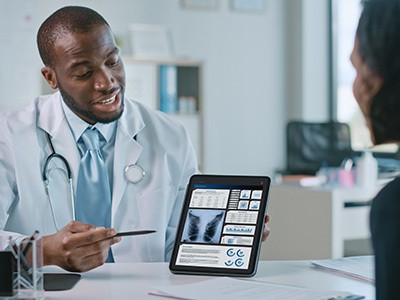Lung cancer claims more lives than colon, breast, and prostate cancers combined. Historically, lung cancer has been more common in older adults and diagnosed at an advanced stage. Younger women, however, are getting lung cancer at higher rates than men younger than 50, according to a report published in JAMA Oncology.
There are two types of lung cancer: small cell and non-small cell lung cancer. Most cases of non-small cell lung cancer (NSCLC) are caused by smoking (around 90%). But lung cancer can also be caused by using other forms of tobacco, such as pipes or cigars, secondhand smoke, air pollution, radon and asbestos exposure, family history of lung cancer, and certain gene mutations.
The most important thing you can do to prevent lung cancer is to quit smoking (if you smoke), stay away from all types of tobacco, and avoid breathing secondhand smoke. Here are other key points and ways to protect yourself:
What are the early signs of lung cancer?
Most people with lung cancer will not have symptoms until the cancer is advanced. Some people have symptoms related to the lungs or other parts of their body if the cancer has spread (metastasized). Others have general symptoms of feeling unwell, such as exhaustion, aches or pains when breathing or coughing, and loss of appetite or unexplained weight loss. Other common symptoms include coughing up blood, recurring chest infections, and shortness of breath.
Who should be screened for lung cancer?
Screening means testing people with no symptoms to determine their likelihood of having that disease. Generally, lung cancer imaging tests only screen for non-small cell lung cancer (NSCLC). To qualify for lung cancer screening, you must be a long-term smoker between ages 50 and 80, have smoked at least 20 “pack-years,” and either still smoke or have quit within the last 15 years. Of note, a pack-year is smoking an average of one pack of cigarettes per day for one year. For example, a person could have a 20-pack-year history by smoking one pack a day for 20 years or two packs a day for 10 years. An annual low-dose CT scan is recommended for people who qualify for lung cancer screening by the U.S. Preventive Services Task Force (USPSTF).
How can I prevent or reduce my odds of lung cancer?
Quitting smoking and avoiding secondhand smoke is the first and best step to reducing your lung cancer risk. That includes making your home and car smoke-free and not breathing in smoke from other people’s cigarettes, cigars, or pipes. Here are other actions you can take to lower your risk:
Avoid radon and asbestos exposure. Working with or living near cancer-causing materials can also increase the risk of developing lung cancer. Such chemicals include radon, a colorless, odorless, naturally occurring radioactive gas found outdoors and indoors (elevated radon levels have been found in every state). Long-term radon exposure can lead to lung cancer. Some miners and other underground workers are more likely to come in contact with high radon levels. However, radon exposure is also possible in homes, offices, and schools. With that in mind, the U.S. Environmental Protection Agency recommends that all homes be tested for radon.
Avoid or limit exposure to cancer-causing agents. Other chemicals and materials linked to lung cancer (also known as carcinogens) are common in certain workplaces and include:
Radioactive ores such as uranium
Inhaled chemicals such as arsenic, beryllium, cadmium, silica, vinyl chloride, nickel compounds, chromium compounds, coal products, mustard gas, and chloromethyl ethers
Diesel exhaust
If you work around any of these agents, do what you can to follow health and safety guidelines and limit your exposure whenever possible.
Eat a healthy diet. A healthy diet rich in fruits and vegetables may also help reduce your risk of lung cancer. Some evidence suggests that a diet high in fruits and vegetables may help protect smokers and nonsmokers; however, any potential benefit from fruits and vegetables would be much less than the increased risk from smoking.
How can I quit smoking?
The first step is to decide to quit and begin making a quit plan. That includes seeking help and guidance from a health care professional or a quitline coach (1-800-QUIT-NOW). In fact, counseling can help you plan to quit smoking and cope with the stress and urges expected when trying to quit. Remember, nicotine is an addictive substance, and quitting may require medication. Your provider may suggest over-the-counter nicotine replacement therapy (NRT), prescription medication, or a combination of both. Counseling and medication together give you the best chance of quitting for good.
The takeaway
Lung cancer is by far the leading cause of cancer death for both men and women, and smoking is the main culprit. Nonsmokers can also develop lung cancer due to secondhand smoke, radon exposure, and genetic predisposition. An annual low-dose CT scan is recommended for anyone between ages 50 and 80 who smoked at least a pack of cigarettes a day for 20 years or more and who currently smokes or has quit within the last 15 years. The scan only takes a few minutes and is not painful. It is important for patients to share their smoking history with their health care professionals. Ask a St. Luke's Health provider about screening if you’re at risk for lung cancer or for counseling and support quitting.
Sources:
Who Should Be Screened for Lung Cancer? | CDC
Non-small cell lung cancer: MedlinePlus Medical Encyclopedia
Lung Cancer Fact Sheet | American Lung Association
Basic Information About Lung Cancer | CDC
Lung Cancer Prevention | How to Prevent Lung Cancer | American Cancer Society
How to Quit | Smoking & Tobacco Use | CDC




